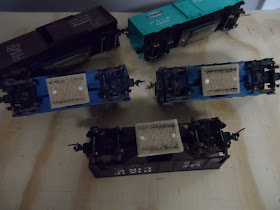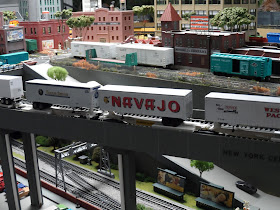Happy 80th Birthday to the EMD F Units!
The bull nosed F units, the brainchild of EMD Engineering Dept boss Richard M. Dilworth and his staff, were introduced at a time when steam power ruled the rails.
On November 25, 1939 four unit FT demonstrator set number 103 left the EMD Plant at La Grange IL for an eleven month, 83,764 mile, twenty railroad, thirty five state demonstration tour. History shows us it was a very successful tour.
The Terminal Yard engine terminal is happy to host and celebrate an 80th birthday tribute to the EMD F units!
The Terminal Yard engine terminal is happy to host and celebrate an 80th birthday tribute to the EMD F units!
F Unit construction ended in 1960 with camera shy New Haven FL9 #2059 being the last unit built. A total of 7,628 F Units were constructed and sold.
The Big Seller
The A.T.S.F. was the biggest buyer of the original FT engines purchasing 155 A units and 165 B units. During World War II the War Production Board placed restrictions on manufacturing and allocation of diesel locomotives. The Santa Fe was a vital route to the west coast and had priority for acquiring the FTs. The Santa Fe would buy 910 F units and their war bonnet model train is the best selling engine of all time by far.
The Lightning Stripe
The New York Central purchased four FT A units and four FT B units. The A-B sets were draw bar equipped and this was pretty much the early FT standard except for the A.T.S.F units. The FTs served the NYC well and one AB set last into the mid 60's. These units are painted in a revised lightning stripe scheme. Revising the F Unit for Mass Production
In 1945 EMD estimated that the assembly of a four unit FT set would take 40,000 man hours of labor. Ass't EMD Chief Engineer Eugene Kettering and the Engineering Dept began work on a new design suitable for mass production of the next F Units that would enter a highly competitive market now that WWII was over. The 1,350 HP EMD F2 would be built from July 1946 thru November 1946 and sell 74 A units and 30 B units.
The 1,500 HP EMD F3 would be built from July 1945 to February 1949. The F3 hosted many improvements and sold 1,006 A units and 694 B Units.
The Greyback
The CB&Q purchased 53 F3As and 52 F3Bs. A distinctive spotting feature are the chicken wire grills and high profile fans. These Proto 1000 CB&Q F3As wear the freight "Greyback" paint scheme.The F3 also introduced passenger equipped A and B units. The NYC purchased two sets of such F3A units for use on their B&A lines. These were numbered 3500, 3501,3502, 3503 Their steam generators were removed in 1961, at which time were renumbered 1874, 1875, 1876, 1877, painted in the black freight scheme and assigned back to freight service. The 1876 would be renumbered to 1801 replacing the first 1801 that was damaged and scrapped.
Non Prototypical Lightning Stripes
This MRC Platinum passenger equipped and painted F7A has been on my roster for about 25 years. It has the F3 passenger scheme but is totally non prototypical. It's such a good looking engine though, I'll never repaint it.
The Lightning Stripe Fleet Grows
A more traditional New York Central F7 A-B-B-A lash up idles at the Terminal Yard engine facility. EMD produced 2,393 F7As and 1,463 F7Bs. The NYC purchased 238 A units and 55 B units.
The NYC Cigar Band
In the 1960s the NYC began applying the cost saving cigar band scheme to their cab units. This A-B-A set would wear this paint scheme to the end of the NYC.
The Pennsy Freight Fleet
The Pennsylvania RR was another big buyer of the F series locomotives. The Pennsy purchased 80 F3A and 40 F3Bs then came back for 123 F7As and 76 F7Bs. During 1948 - 1950 PRR bought 69 F3s and F7s in A-B-A sets for helper service west of Altoona PA.Spartan Paint
As the Alleghenies took their toll on the PRR F3s and F7s their paint schemes became very spartan as the merger with the NYC loomed closer.
Pennsy Passenger Units?The Dual Service FP7
One class of F units that would come off the PRR mostly intact were forty dual service FP7s and 14 concurrent steam equipped F7Bs. The PRR 9832-9835 came painted in the passenger Tuscan red with five stripes. The rest were painted in the DGLE with a single buff stripe freight scheme. Penn Central inherited them all assigning them to mail trains in four and five unit sets, freight service and helper service. Seventeen FP7s and two of the F7Bs made it to Conrail but none were painted blue. Mating Worms
The Penn Central would inherit another 281 F units that would soldier on out of Collinwood Yard where they were based. Some would see service for Conrail. Conrail Blues
In April 1976 Conrail took over the ashes of the bankrupt Northeast Railroads and inherited their mostly worn out fleets which included 110 EMD F7As from the PC and EL. Conrail did paint at least one F unit blue, CR 1792, but none received the can opener logo or Conrail lettering. This Mantua product has some other discrepancies as well. Is it 6302 or 6502? Part of my son's fleet it runs very well. Don't tell him I messed up the number boards.
Seven cars to an F Unit
On the B&O Railroad it was seven cars to an F unit on the B&O's west end mountain battleground in 1960. Those B&O F units made their living working the famed 2.4% Cranberry Grade and 2.28% Seventeen Mile Grade on the slopes of the Allegheny Mountains. Used in head end and helper service A-B-A and A-B-B-A sets moved everything from coal drags to Time Saver freights.
Chessie F7?
This old Bachmann C&O 7071 looks sharp in this Chessie System livery. I'm almost positive the 7071 nor any of the other 93 C&O F Units received this paint scheme after the formation of the Chessie System in 1972.
More F7 Fleets Combined
The Erie Lackawanna RR when formed in 1960 inherited six F7As and 6 F7Bs from the Erie, nine F7As and 6 F7Bs from the D.L.&W. The ex Erie units were numbered 7111-7133 and the ex D.L&W. in the 6311-6362. As late as October 1974 the EL ran true A-B-A sets on revenue trains.
The one of a kind FL9
Athearn BB New Haven Railroad passenger equipped F7As idle at the Terminal Yard engine facility pretending to be New Haven FL9s. Introduced in 1956 the NH purchased sixty of the unique dual mode FL9s for commuter service into Grand Central Terminal. The FL9 was eight feet longer than the standard F9 featuring a B-A1A truck arrangement with third rail shoes for electrical pickup.After joining the Penn Central many of the NH FL9s migrated to the former NYC Hudson and Harlem lines to eliminate the diesel for electric changes at Harmon and North White Plains. The FL9s wore many different paint schemes during their years of service with the survivors ending their careers on the Metro North Commuter Railroad and the Connecticut Department of Transportation.
F Units on Parade
Final Thoughts
The EMD F Units to me are timeless classics with their beautiful factory paint jobs that gave us war bonnets, lightning stripes, and other classic schemes for every railroad that purchased one. They were reliable power in passenger, freight and helper service. Even as they aged they retained their class and dignity in faded paint and patch outs.
Restored F Unit in Revenue Service
F unit fans will be happy to know that at least one F unit is still in revenue service in 2020. Checkout this video of the Clinchfield 800.
Thanks for reading and watching!!!!See ya soon!!!




























































